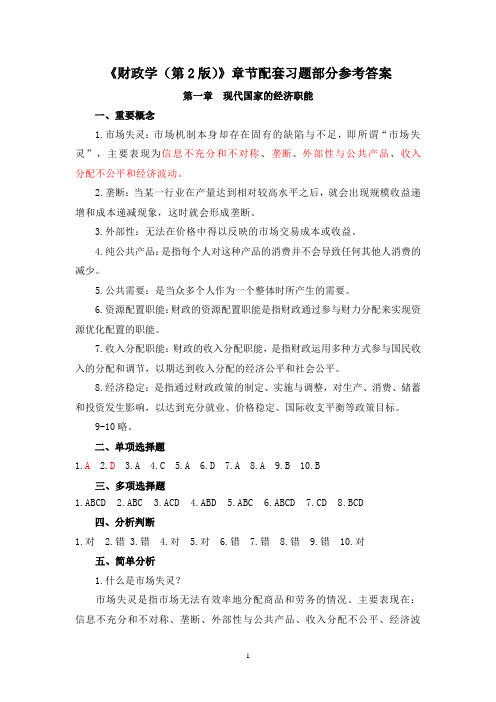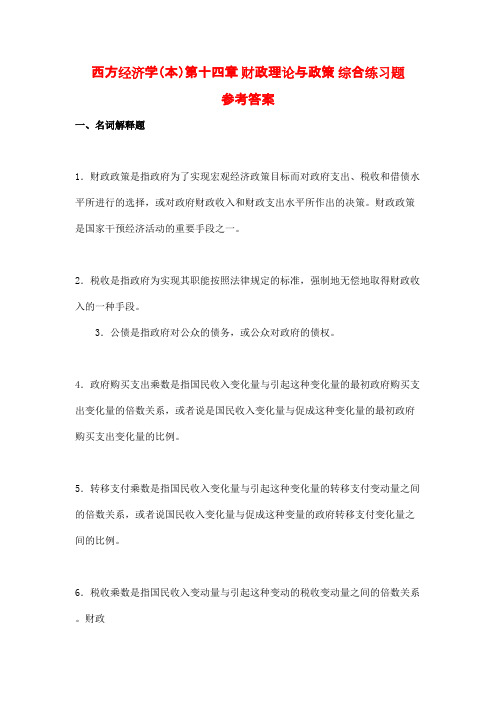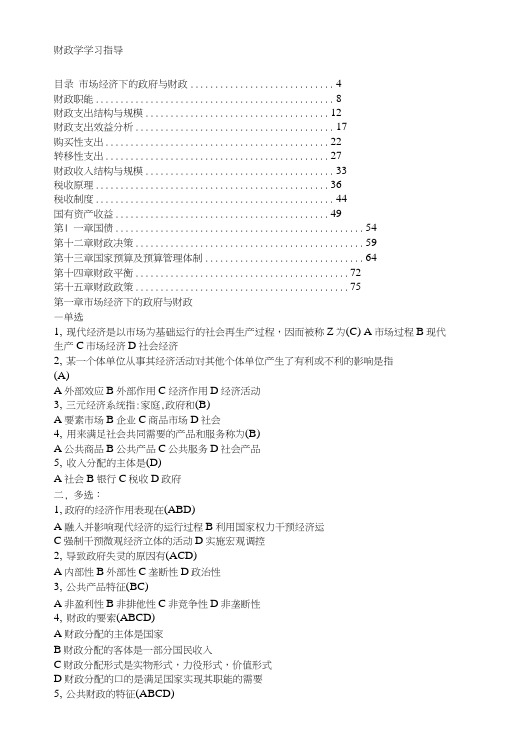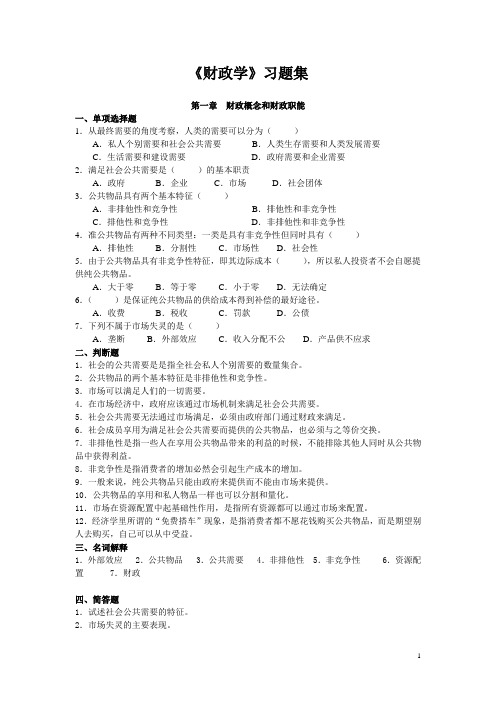财政学第十四章答案
财政学(第2版)习题答案

《财政学(第2版)》章节配套习题部分参考答案第一章现代国家的经济职能一、重要概念1.市场失灵:市场机制本身却存在固有的缺陷与不足,即所谓“市场失灵”,主要表现为信息不充分和不对称、垄断、外部性与公共产品、收入分配不公平和经济波动。
2.垄断:当某一行业在产量达到相对较高水平之后,就会出现规模收益递增和成本递减现象,这时就会形成垄断。
3.外部性:无法在价格中得以反映的市场交易成本或收益。
4.纯公共产品:是指每个人对这种产品的消费并不会导致任何其他人消费的减少。
5.公共需要:是当众多个人作为一个整体时所产生的需要。
6.资源配置职能:财政的资源配置职能是指财政通过参与财力分配来实现资源优化配置的职能。
7.收入分配职能:财政的收入分配职能,是指财政运用多种方式参与国民收入的分配和调节,以期达到收入分配的经济公平和社会公平。
8.经济稳定:是指通过财政政策的制定、实施与调整,对生产、消费、储蓄和投资发生影响,以达到充分就业、价格稳定、国际收支平衡等政策目标。
9-10略。
二、单项选择题1.A2.D3.A4.C5.A6.D7.A8.A9.B 10.B三、多项选择题1.ABCD2.ABC3.ACD4.ABD5.ABC6.ABCD7.CD8.BCD四、分析判断1.对2.错3.错4.对5.对6.错7.错8.错9.错 10.对五、简单分析1.什么是市场失灵?市场失灵是指市场无法有效率地分配商品和劳务的情况。
主要表现在:信息不充分和不对称、垄断、外部性与公共产品、收入分配不公平、经济波动与失衡。
2.垄断导致的效率损失表现在哪些方面?垄断导致效率损失:(1)产量受到限制,消费者福利受到额外损失;(2)垄断行业由于追求并事实存在垄断利润,缺乏尽可能降低成本的竞争压力;(3)垄断阻碍技术进步;(4)垄断者追求超额收入的寻租活动本身会造成资源浪费。
4.简述财政的基本特征。
第一,财政分配的主体是国家或政府。
第二,财政分配的对象是部分社会产品与服务。
西方经济学(本)第十四章 财政理论与政策 综合练习题参考答案

西方经济学(本)第十四章财政理论与政策综合练习题参考答案一、名词解释题1.财政政策是指政府为了实现宏观经济政策目标而对政府支出、税收和借债水平所进行的选择,或对政府财政收入和财政支出水平所作出的决策。
财政政策是国家干预经济活动的重要手段之一。
2.税收是指政府为实现其职能按照法律规定的标准,强制地无偿地取得财政收入的一种手段。
3.公债是指政府对公众的债务,或公众对政府的债权。
4.政府购买支出乘数是指国民收入变化量与引起这种变化量的最初政府购买支出变化量的倍数关系,或者说是国民收入变化量与促成这种变化量的最初政府购买支出变化量的比例。
5.转移支付乘数是指国民收入变化量与引起这种变化量的转移支付变动量之间的倍数关系,或者说国民收入变化量与促成这种变量的政府转移支付变化量之间的比例。
6.税收乘数是指国民收入变动量与引起这种变动的税收变动量之间的倍数关系。
财政7.平衡预算乘数是指政府收入和支出以相等数量增加或减少时,国民收入变动量为政府收支变动量的倍数。
8.制度的自动稳定器是指政府税收与转移支付具有适应经济波动而自动增减,并进而影响社会总需求的特点,一般称这样的财政政策及其效应为财政制度的自动稳定器。
9.挤出效应是指增加政府投资对私人投资产生的挤占效应。
从而导致增加政府投资所增加的国民收入可能因为私人投资减少而被全部或部分地抵消。
10.财政赤字:又称预算赤字,是一国财政年度支出超过年度收入的差额。
二、单项选择题1.B2.A3.C4.C5.A6.A7.C8.A9.C10.B11.C 12.A13.C14.A15.A16.A17.B18.A19.A20.D 三、多项选择题1.ABC2.BCD3.CDE4.AD5.BCD6.BC7.ADE8.ABC9.AB10.AC 四、判断分析题1.×2.×3.√4.×5.×6.√7.×8.√9.×10.√11.√12.×13.√14.√15.√√ 五、计算题1.如果政府通过征收1000亿元的税收和支出1000亿元的购买以求得预算的平衡,当边际消费倾向为80%时,求对国民收入的影响。
财政学第十四章 政府预算及其管理4.13 13.政府预算及其管理

(一)国家决算的编制
国家决算的编制意义 国家决算体系构成 国家决算的编制程序及法律要求
(二)国家决算的审查与批准
国家决算审查的内容有三个方面: 政策性审查,主要是从贯彻执行党和国家的各 项方针政策、财政制度、财政纪律等方面进行 审查; 技术性审查,主要是从决算报表中的数字关系 方面进行审查; 预算管理审查,主要是审查预算管理体制规定 的收支划分、上下级财政部门之间收入的分成 比例执行是否正确,以及当年决算收支平衡情 况等。
要求而确定的各级预算级次,按一定组合方式组 成的统一体,即为政府预算体系。 在单一制国家中,预算可以分为中央预算和各
级地方政府预算。 在联邦制国家中,预算可以分为联邦预算、州
(邦)预算和地方预算。 我国政府预算构成是与我国政权结构和行政区
域的划分和适应的,总体上是由中央预算和地 方预算组成。
国库单一帐户制度
国库单一账户制度是指政府所有财政性资金集中 在国库或指定的代理行开设帐户,所有财政资金 收付都通过财政部门在国库银行开设的单一帐户 集中办理,实行财政直收直支。
国库单一账户制度的主要做法: 建立国库单一账户体系 规范收入收缴程序 规范支出拨付程序 设立“国库集中支付中心”
一般不得预算调整
- 19 -
三、国家决算
国家决算是根据年度预算执行结果而编制的年度 会计报告。它是预算执行的总结,其实质属于预 算事后审计。
国家决算主要的工作内容
预算执行机构编制决算报告 审计机构审核决算报告 立法机构审批决算
批准国家决算标志着该预算年度的预算程序结束。
二、政府预算的执行与调整
(一)政府预算的执行机构及主要工作内容 政府预算的执行机构
邓子基《财政学》(第2版)课后习题(第14章 税收制度)【圣才出品】

第14章税收制度一、概念题1.所得课税/收益课税答:所得课税是以纳税人的所得为征税对象的税类,主要包括个人所得税、公司所得税、社会保险税(工薪税)等。
它具有以下几个特点:①征税对象是扣除了各项成本、费用开支之后的净所得额。
一定时期内的国民收入经过初次分配和再分配过程,大体形成:工资、股息、利息、未分配利润、租金等份额。
②税负具有直接性。
所得课税一般以企业或个人作为纳税人,并由企业和个人最终承担税负。
③税收课征的公开性。
所得课税无法转嫁,在收入分配环节进行课征,并针对企业利润或个人所得征收,直接关系到所得的归属问题。
④较能体现税收公平原则。
所得课税的立法普遍遵循“多得多征,少得少征,无所得不征”的原则。
⑤税收管理的复杂性。
所得课税依纳税人的实际纳税能力征收,在确定应税所得额时往往要经过一系列复杂的程序。
2.流转课税/商品课税答:流转课税是以商品和劳务的流转额为征税对象的税类,国际上统称为“商品和劳务税”,主要包括增值税、营业税、消费税和关税等。
按计税方式的不同,流转课税可以分为从量税和从价税。
流转课税的特点:①流转课税的课征对象是商品和劳务的流转额,因而与交易行为有着密切的联系;②流转课税在负担上具有累退性;③流转课税的税源普遍,课税隐蔽;④流转课税具有征收管理的简便性;⑤配合社会经济政策的针对性。
从课税范围看,流转课税可以有三种选择:①除全部消费品外,还将资本品和交通运输等纳入商品课税范围;②对全部消费品课税,资本品和劳务则被排除在课税范围之外;③选择部分消费品课税。
从税基看,流转课税可以分为三种类型:①按商品和劳务的销售收入总额课征;②按商品流转所增加的价值额课征;③按部分商品和劳务的销售额课征。
3.财产课税答:财产课税是以纳税人拥有或支配的财产为征税对象的税类,主要包括一般财产税、特种财产税、财产转让税(如遗产税和赠与税)等。
对财产课税,要考虑到纳税人的负担能力,要有利于公平税负和缓解财富分配不均的情况,有利于发展生产、抑制不合理消费和不合理使用资源。
14财政学(第十四章)--预算管理体制

第十四章预算管理体制第一节预算管理体制概述第二节中国分税制改革第一节预算管理体制概述●预算管理体制及其类型预算管理体制是处理中央和地方以及地方各级政府之间的财政关系的基本制度,其核心是各级预算主体的独立自主程度以及集权和分权的关系问题。
预算管理体制的主要内容包括:(1)确定预算管理主体和级次;一般是一级政权即构成一级预算管理主体(2)预算收支的划分原则和方法;(3)预算管理权限的划分;(4)预算调节制度和方法。
预算管理体制的类型:预算管理体制类型划分的主要标志是各级预算主体的独立自主程度,核心问题是地方预算是否构成一级独立的预算主体。
中国预算管理体制类型变化:(1)统收统支体制(1949-1953) ;(2)“统一领导、分级管理”体制(1953-1978);(3)“划分收支、分级包干”体制(财政包干体制)(1980-1993);(4)分级预算体制或分税制体制(1994-)。
●分级分税预算管理体制简介——分级分税预算管理体制的要点分级分税预算管理体制是实行市场经济国家普遍采取的一种预算体制,在西方财政学中称之为财政联邦主义。
财政联邦主义不是专指联邦国家的财政体制,而是有关多级财政体制的概念。
分级分税预算管理体制可归纳为以下几个要点(1)一级政权,一级预算主体,各级预算相对独立,自求平衡;(2)在明确市场经济下政府职能边界的前提下划分各级政府职责(即事权)范围,在此基础上划分各级预算支出职责(即财权)范围;(3)收入划分实行分税制;(4)建立预算调节制度,即所谓转移支付制度,调节政府间收支差距;有纵向调节(或纵向转移)和横向调节(或横向转移)两种形式。
(5)各国的分级预算体制是适应本国的政治经济制度和历史传统长期形成的,就体制整体而言是相对稳定的,只是集权与分权关系及其相应的调节方法可以有经常的调整。
●分级分税预算管理体制简介——收支划分的基本理论依据1.社会公共需要或公共物品的层次性公共需要的层次性包含两方面的内容:(1)从支出角度分析,接受益范围为标准区分的层次性。
财政学各章问题答案(最新整理)

财政学各章问题答案 导论1.财政学的对象范围和研究范围的联系与区别?①财政学的研究范围不同于对象范围,它要比对象范围宽泛。
②财政学的对象范围主要是阐述财政学的特有任务,弄清财政学所要探明的特殊矛盾产生、发展、变化的规律;而财政学的研究范围除对象范围外,还需要联系其他方面或学科来加以研究。
2.财政政策与财政制度是否属于财政学的研究对象?①财政政策是国家为实现一定时期的政治经济任务,在财政方面制定的处理各种财政活动的规则和秩序,是对财政关系的强制规定,它是根据统治阶级利益处理财政活动关系的准绳。
②财政制度是根据党和国家的路线、方针、政策制定的财政工作的依据和规范,即规范财政活动关系的具体形式。
③财政学的研究对象是国家参与一部分社会产品或国民收入分配与再分配所进行的一系列经济活动中存在的分配关系及其发展规律。
它不同于财政学的对象范围。
④财政政策、财政制度不属于财政学的研究对象。
3.现代财政学与传统财政学的主差异表现在何处?①现代财政学认为,传统的财政范畴,如税收、支出、公债、预算等只是财政学主题的一部分,必须跳出财政谈财政。
②现代财政学认为,国家应干预经济,而且财政政策的实施对总体经济活动水平有相当大的影响。
③总之,现代财政学已不限于财政收支管理,更不能限于货币资金管理,而要结合到资源的配置、收入的分配、经济的稳定,从政府和市场的相互作用,从宏观和微观的角度进行研究,甚至有人提出用“公共部门经济学”或“政治经济学”等名称来代替财政学。
4.财政学的研究方法有哪些?①从本质上来说是马克思主义的唯物辩证法;②从具体方法来说,包括历史的方法、统计的方法、宏观分析方法和制度分析方法等等,但主要是实证分析、规范分析及其统一。
第一章1. 财政是如何产生的?①财政的产生需要两个条件:一个是经济条件,另一个是政治条件。
②经济条件是财政产生的首要条件。
只有当剩余产品出现以后,财政才有了存在的物质基础。
③政治条件是财政产生的必要条件。
财政学题目

第十四章财政政策与宏观调控一、填空题1、宏观财政政策通常包括三种类型:_____________、_____________和________________。
2、财政对宏观经济的调控目标有_____________、_____________和________________。
二、单项选择题1、当社会总供给大于社会总需求时,应采取()A.大于支出的结余政策B.支出大于收入的赤字政策C.收支平衡的中性政策D.收支相等的平衡政策2、能自动发挥作用使宏观经济趋向稳定的政策效应叫()A. 内在稳定器B. 乘数效应C. 奖抑效应D. 货币效应3、扩张性财政政策可通过以下方式达到()A. 减少政府支出或增加税收B. 增加政府支出或减少税收C. 只能减少政府支出D. 只能增加税收4、紧的财政政策与松的货币政策搭配指的是()A.扩大财政赤字和收紧信贷规模B.减少财政赤字和收紧信贷规模C.扩大财政赤字和扩张信贷规模D.减少财政赤字和扩张信贷规模5、在经济衰退时期,财政政策的内容是()A.税收减少,政府支出减少B.税收减少,政府支出增加C.税收增加,政府支出减少D.税收增加,政府支出增加6、B为边际消费倾向,那么税收乘数是()。
A.1/(1-b)B.-b/(1-b)C.1D.b/(1-b)三、多项选择题1、财政政策的三大目标包括()。
A、充分就业B、物价稳定C、国际收支平衡D、100%的就业率E、鼓励出口2、扩张性财政政策的内容有()A.扩大财政支出规模B.增加税收C.扩大国债发行D.增加财政结余E.实行赤字预算3、为了达到抑制社会总需求的目的,应该()A.增加税收B.减少税收C.增加财政补贴D.减少财政补贴E.增加财政支出4、各国中央银行掌握的货币政策工具主要有()A.法定存款准备金B.公开市场业务C.再贴现D.利率E.货款规模控制5、总供给大于总需求的情况下,政府财政收支调节可采取的措施是()A. 扩大财政支出B. 削减税收C. 减少财政支出D. 增加税收E. 扩大财政支出的同时,削减税收四、判断题1、当社会总需求小于社会总供给时,可以通过实行财政预算收入大于支出的结余政策进行调节。
《财政学》第四版(陈共)课后习题答案中国人民大学出版社.docx

财政学学习指导目录市场经济下的政府与财政 (4)财政职能 (8)财政支出结构与规模 (12)财政支岀效益分析 (17)购买性支出 (22)转移性支出 (27)财政收入结构与规模 (33)税收原理 (36)税收制度 (44)国有资产收益 (49)第| 一章国债 (54)第十二章财政决策 (59)第十三章国家预算及预算管理体制 (64)第十四章财政平衡 (72)笫十五章财政政策 (75)第一章市场经济下的政府与财政—单选1,现代经济是以市场为基础运行的社会再生产过程,因而被称Z为(C) A市场过程B现代生产C市场经济D社会经济2,某一个体单位从事其经济活动对其他个体单位产生了有利或不利的影响是指(A)A外部效应B外部作用C经济作用D经济活动3,三元经济系统指:家庭,政府和(B)A要素市场B企业C商品市场D社会4,用来满足社会共同需要的产品和服务称为(B)A公共商品B公共产品C公共服务D社会产品5,收入分配的主体是(D)A社会B银行C税收D政府二,多选:1,政府的经济作用表现在(ABD)A融入并影响现代经济的运行过程B利用国家权力干预经济运C强制干预微观经济立体的活动D实施宏观调控2,导致政府失灵的原因有(ACD)A内部性B外部性C垄断性D政治性3,公共产品特征(BC)A非盈利性B非排他性C非竞争性D非垄断性4,财政的要索(ABCD)A财政分配的主体是国家B财政分配的客体是一部分国民收入C财政分配形式是实物形式,力役形式,价值形式D财政分配的口的是满足国家实现其职能的需要5,公共财政的特征(ABCD)A公共性B非盈利性C法治性D民主性6,完全竞争市场的条件是(ABCD)A在市场上有众多的买者和卖者B各种资源都能够自由地通过市场转移C生产者和消费者具冇完全信息D生产者所提供的同种产品是同质的三,简答1,什么是市场失灵及市场失灵的表现答:在完全竞争条件下,市场经济能够依靠口身的力量进行调节,达到社会资源有效配置的状态•但是,在一些领域或场合,市场机制木身并不能得到有效发挥,而在另外一些领域或场合,市场机制即使能够充分发挥,也无法达到符合整个社会要求的资源配置结果.这些问题是市场经济口身所无法克服的a有缺陷,一般统成为市场失灵.市场失灵主要表现为以下几个方而:外部效应.外部效应是指某一个体单位从事其经济活动对其他个体单位产生了有利或不利的影响,但并不因此而承担相应的成木费用支出或从屮分享好处.公共产品•公共产品是指具冇公共消费或集体受益的物品与劳务•诸如国防,社会治安,公共设施,公共环境保护等,都是典型的公共产品.市场垄断•当某一行业的产量达到相对较高的规模时,就会出现规模收益递增和成本递减的趋势,从而就会形成垄断.不完全市场•在现实的市场体系屮,有些环节带有明显的残缺特征•这种情形主要发生在以下市场领域:保险市场,资本市场,互补市场.不完全信息•但从现实看,尽管生产者和消费者都能在一定程度上可以得到a己所需的信息,却无法得到完全足够的信息.收入分配不公•在市场经济运行中,由于社会,政治,经济体制的限制和影响,由于人们的社会地位和自然禀赋方面存在的差异,同吋,也由于人们的生活环境,受教育程度,劳动技能,劳动能力等冇所不同,使得利润,工资等收入并不能完全取决于竞争条件卜•的要素价格.结果,经济效率越高,往往伴随着越不公平的分配.显然,这是市场自身的力量难以改变的.宏观经济的失衡•山场经济稳定运行的基本条件之一是保持总供给与总需求的平衡.但是,由于市场经济内部各种矛盾的相互交织,总供给与总需求之间总是在不平衡到平衡再到不平衡的关系中循环发展的.2,公共产品的分类及其提供方式答:根据公共产品的特征,可以将公共产品划分为纯公共产品和准公共产品. 由于公共产品的性质并非完全相同,因此,公共产品的提供方式也不一样•其基本原则是:纯公共产品由政府提供,准公共产品则要同时借助于政府和市场的力量共同提供.由于公共产品具有非排他性和非竞争性的特征,对它的需要或消费是公共的或集合的•如果由市场捉供,每个消费者都不会自愿掏钱去购买,而是等待他人去购买,自己则免费搭车.在这种情况下,公共产品提供不能由私人去完成,而只能作为政府的责任•対于许多准公共产品而言,采取由市场机制和政府机制协同提供的方式则更加切实口j行的.3,阐述财政的内涵.答:财政是为了实现国家的职能,满足社会的公共需要,并以国家为主体,借助于政府的预算收支,对一部分社会产品进行集中性分配的形式.对此,我们可做如下理解:财政是一个分配范畴.国家财政是分配环节内的一种形式,特别是在再分配过程中, 它是一种主要的分配形式.财政分配的主体是国家(或政府).财政分配的主体是国家或政府.所谓国家为主体,是指国家在财政分配屮居于主导地位.财政分配的客体是一部分社会产品•在国民收入中既劳动者的必要价值,也包含剩余产品价值•这为财政分配对象的确立提供了基础.财政分配的形式与一定的经济形态相联系.财政分配采取什么形式,与社会经济发展的进程有关.财政分配的口的是满足国家实现其职能的需要•国家拥有两大基木职能,即社会管理职能和经济管理职能,就要求通过国家依靠政治权利,参与社会产品的分配,因此,财政分配就是满足国家实现其职能的物质需要.财政分配的过程主要依靠政府预算收支来实现.政府预算是国家经过政治和法律程序确定的财政分配规则和标准,是财政进行集中性分配重要标志.4,我国发展公共财政的必要性和可能性答:(1)发展公共财政的必要性:第一,发展公共财政有利于解决财政职能的混乱现象.我国财政模式必须走出原來的生产建设型模式,积极转向公共财政模式,并按照弥补市场失灵的原则,重新界定财政活动的范围,避免政府及其财政对正常的和正当的市场活动进行干预•这有利于把我国财政建设成功能完整,高效率运行的财政.第二,发展公共财政冇利于促进各个经济主体的公平竞争•财政按照公共性方向发展,很重要的一点就是要求财政政策为市场提供一视同仁的待遇和服务.生产经营如何决策,屈于企业t己的事情,财政所要做的就是为企业的发展创造良好的外部条件•无论哪一种类型的企业,只要是合法经营,都是我国市场经济发展的组成部分,也都是需要鼓励和保护的. 第三,发展公共财政冇利于加快我国财政的民主化和法治化建设•毋庸讳言,在整个高度集中的计划经济时期,我国财政完全处于人治的环境z卜••改革开放以來,随着国家政治经济的民主化和法治化进展,财政的人治局而冇所改观,但情况仍然不容乐观•税收减免的随意化,资金分配的暗箱操作,纳税人对口身权利的漠视,预算外资金管理的阻力,都有待我们通过建立公共财政模式逐步加以解决.⑵发展公共财政的口J能性:随着市场化改革的推进,市场机制在资源配置的过程中起到了基础性的作用.这使得财政制度的转变直接立足于社会主义市场经济基础Z上的公共财政的框架Z屮•在这一背景下,吸收,借鉴西方财政理论,发展我国公共财政己成为可能. 四,论述:分加阐述国家分配论和公共财政论的基本观点,并比较二者的异同.答:(1)国家分配论的基本观点国家分配论是关于国家财政的本质观•它是我国财政学界在20世纪50年代末60 年代初,创立并逐步完善的一种财政学说,长期以来,对我国财政理论体系的建立作除了重要贡献•其基木观点包括:财政的产生问题•财政是在出现了国家之后才产生的,国家的存在和实现其自身职能需要耗费一定的物质资料,但国家口身又不生产.所以,国家就依靠口身的权力,强制的,无偿的占冇一部分社会产品,来满足自身职能的需要•从而在整个社会产品的分配中,独立出一种由国家凭借其政治权利直接参与社会产品分配,这就是财政.财政与国家的关系.财政与国家相依为命,共存共荣.财政的基本要素.国家是分配主体,社会的剩余产品是分配对象,满足其自身职能是分配目的,至于分配形式,在自然经济条件下,实物和力役,在现代经济条件下是货币形式.财政的本质•分配即为其本质.(2)公共财政论的基本观点公共财政是植根于西方市场经济土壤屮的财政学.财政的起因•在完全竞争条件下,由场经济能够依靠口身的力量进行调节,达到社会资源有效配置的状态•但是,在一些领域或场合,市场机制木身并不能得到有效发挥,而在另外一些领域或场合,市场机制即使能够充分发挥,也无法达到符合整个社会要求的资源配置结果•这些问题是市场经济口身所无法克服的a有缺陷,一般统成为市场失灵.为解决市场失灵,政府必要直接干预,财政作为干预重要手段必要介入其中.财政的对象•财政活动的对象是为市场经济屮的家庭和企业提供公共服务,即广义上的公共产品.财政的目的•公共需要指的是社会公众对于公共服务的需要•对于具备共同消费性质的公共服务来说,它是难以通过市场机制得到冇效供给的,但以为社会公众所必需,这就需要由非市场的力量,通过非私人经济的活动来提供•由此,满足公共需要的职责是财政活动的口的.财政决策•公共产品的冇效供应是建立在个人效用和偏好的基础之上的,经过选民公决或议会投票程序,将他们各口对于公共产品的欲望和偏好反映出來,从而为政府捉供公共产品的预算决策分析捉供依据•由于个人z间对于公共产品的偏好总或多或少存在着矛盾和偏差,公共选择在公共决策中优为重要.⑶国家分配论和公共财政的比较国家分配论与公共财政论既冇区别,也冇共性•首先,国家分配论解答财政在本质上是什么的问题,它适用于所有财政的类型•而公共财政论是从财政运行模式或类型的角度解剖财政,具体说是对特定时期或特定经济体制下财政模式的解答•因此, 两者之间属于一般和特殊的关系.公共财政只是国家财政在特定历史阶段,即市场经济阶段存在的类型,它不否定国家财政•其次,公共财政论看起来只是给出了财政运行的基本特征和形式,没冇像国家分配论那样明确国家对财政的决定性作用,指出国家是财政分配的主体•但实际并非如此•因为公共财政论强调的重点在于国家与公共利益具有一致性,不能离开国家谈公共财政分配,也不能离开公共需要谈国家作用.公共财政不仅不否定国家的主体地位,而且更加重视国家权力的完整性, 不允许肢解财政分配,分散国家应该统一掌握的必要财力•无疑,这将有助于而非不利于加强国家的宏观调控能力.第二章财政职能一,单选题1,财政职能以政府与(B)的关系为基本立足点.A居民B市场C社会D税收2,判断资源配置优劣的标准是(C)A福利最大化B利润最大化C帕累托最优DGDP最大化3,可就业人口的就业率达到了一个很高的比例是指(D)A低失业B高就业C消灭失业D充分就业4,提高财政配置工具的使用效率主要方法是(C)A降低政府开支B提高经济建设资金C降低税收成本D加快资金循环二,多选题1,市场失灵可以分为(ABC)A市场在资源配置方面的失灵B市场在收入分配方面的失灵C市场在监督方面的失灵D市场在宏观方面的失灵2,国民收入分配包括两个基木的层次(BC)A工资分配B初始分配C再分配D福利分配3,经济增长用(ABCD)衡量A GNPB GDPC 人均GNP水平D 人均GDP水平4,经济活动的两个准则是(CD)A赢利准则B守法准则C公平准则D效率准则5,在正确认识和处理收入差距与效率关系时,应注意(AB)A收入差距的扩大应建立在要素分配的基础上B收入差距要适度C共同富裕D允许非法暴富6,经济稳定包括(ABD)A充分就业B物价稳定C经济持续增长D国际收支平衡7,国际收支逆差导致(AC)A该国外汇储备减少B该国外汇储备增加C木国货币对外币汇率下降D木国货币对外币汇率上升三,简答:1,亦什么实现或提高资源配置的效率需要市场和政府的二元机制答:市场经济条件下的资源配置,自然主要靠市场.因为从总体上说,市场配置是冇效率的,也可以说迄今还没有比市场更有效率的配置机制.然而,市场在资源配置方面也存在着失灵,垄断,信息不充分,外部性与公共物品的存在使市场在资源配置领域难以独善其事,还必须依靠政府的作用來弥补市场的失灵•总之,社会主义市场经济条件卜•资源配置的机制应该是市场和政府共同发挥作用的二元机制.其屮,市场在其屮发挥基础性作用,政府则在市场失灵领域发挥补充作用,二者共存互补,共同承担起优化资源配置的责任.2,简述经济公平和社会公平的区别.答:收入分配的公平包括经济公平和社会公平两项内容.所谓经济公平是指在收入分配中根据在收入创造过程中要素的贡献来决定收入分配的一种准则.没冇贡献要素,没冇资格参与分配,捉供的要素多,收入多,捉供的要素少,收入少.按这样一种规则进行分配是符合经济公平准则的•所谓社会公平是指将收入差距维持在现阶段社会各阶层居民所能接受的合理范围内•至于什么是社会认口J的收入差距,取决于社会普遍接受的价值标准或道德伦理观念•显然,收入差距过大,两极分化与收入差距过小乃至平均主义都不是社会公平准则所不能接受的.经济公平与社会公平是两种不同的公平准则,区别在于二者的着眼点和目的存在明显区别•经济公平着眼于分配的规则或分配过程的公平合理.社会公平着眼于分配的结果,强调收入分配的结果要能为社会所接受;经济公平的目的是分配的效率, 因为只有以按要素贡献为依据进行分配,才能调动人们要素投入的积极性,才有助于捉高效率•而社会公平的目的是要缓解社会不同阶层因收入差距带来的孑盾,追求社会的稳定发展.3,正确理解充分就业.答:止确理解充分就业的概念,应注意以卜•几点:第一,经济学中的就业,是指一切用t己的劳动来维持自己生活的活动.也就是说,个体经营活动,在私营企业和乡镇企业工作以及从事农林牧副渔活动等,均属就业.在我国多数人的传统观念中,只有列入国家招工计划的就业才算就业,这种观念已经过吋,是不正确的;第二,在总人口中总有一部分人是没有工作能力的,在法定就业年龄之下与法定就业年龄之上的人11显然屈于没有工作能力者的范畴.因伤残,疾病和其他原因而不能止常工作的人口也应视为无工作能力•这部分人口不是可就业人口,没冇工作不能算作失业;第三,充分就业不是指可就业人口百分之百的就业.因为在有工作能力的人口屮存在一部分因工资待遇和工作条件等原因而不愿意工作,或者有工作能力且愿意工作但不主动寻找工作的人口•同时,社会经济结构是在不断调整变化的,与此相应,就业结构也在不断变化,在调整就业结构过程中,不可避免地会有一部分人口暂时脱离工作岗位,经过一段时间的学习和训练之后,这部分人口会重新就业经济结构不断调整,就业结构也不断变化,因而在任一时点上,社会总有一部分人处在失业状态•上述的自愿失业和结构性失业在任何国家或社会都是不可避免的, 更不能说明宏观经济运行存在问题•所以,从经济稳定的角度,充分就业不等于百分Z百的就业,而是指可就业人口实现了比较高的就业比率,例如在95%左右.4,区别经济发展和经济增长.答:经济发展与经济增长是不同的概念.增长是指一个国家的产品和劳务数量的增加,通常用国民生产总值(GNP)国内生产总值(GDP)及其人均水平来衡量•发展比壇长的含义要广•它不仅意味着产出的增长还包括随着产出增长而带來的产出与收入结构的变化,以及经济条件,政治条件和文化条件的变化•在一般国家的表现就是在国民生产总值中农业比重下降,而制造业,公用事业,金融贸易,建筑业等二三产业的比重上升,随之就业结构发生变化,教育程度和社会文化水平逐步提高. 简言之,发展是一个通过生产的不断增长来满足人们不断增长的需要的概念,包括消除贫困,失业,文盲,疾病和收入分配不公等现象•一国要最大程度地提高本国国民的社会经济福利,不仅要注重经济增长,更要追求经济发展.5,阐述公平与效率的关系.答:在社会主义市场经济条件下,公平与效率总体上是一种既统一乂矛圧的关系. 其统一性体现在:一方面,经济公平木身就内含着效率原则,因为按要素贡献分配可以促进人们劳动和投资的积极性,可以促进财富的壇长;另一方面,效率也内含着社会公平原则,因为如果资源能够得到有效率的利用和配置,社会财富的增长可以为缩小收入差距,实现社会公平捉供较大的余地和奠定物质基础.但是,在两者实现过程中,乂不可避免地会出现矛盾•因为收入分配上差距的拉大,有助于效率的提高,但差距过大,则可能超过低收入阶层的容忍能力,无疑会伤害社会公平的原则.因此,政府在经济方面的责任,就是通过完善经济体制并运用包括财政在内的政策手段达到公平与效率的基木协调.四,论述:1,论述财政三职能及其各自的实现方式.答:社会主义市场经济条件下财政的职能可以概括为三个方面:资源配置职能,收入分配职能和经济稳定与发展职能.资源配置职能及其实现方式资源配置是指为满足人们的需耍,将冇限的资源在各种可能的用途间进行分配和组合,并形成一定的资产结构,产业结构,技术结构,消费结构和地区结构.资源配置职能的实现方式:(1)合理确定财政收入占国内生产总值的比重,即确定财政资源占社会整体资源的比重,实现社会资源在民间部门和政府公共部门间的合理配置.(2)优化财政支出结构•支出结构也就是财政资源内部的配置比例•如购买性支出与转移性支出的比例以及购买性支出内部的配置比例等.(3)合理运用财政投资,税收,补贴等多种手段调节和引导民间资源的合理配置•未被财政集屮的民间资源的配置原则上属于市场机制作用的范围•当市场本身的配置冇效率时,各种财政政策工具应保持中性,不干扰市场机制的运行•当市场木身的配置效率不高时,可考虑采用非屮性的财政政策手段进行调节,促进民间资源配置效率的提高.⑷ 提高财政配置工具的使用效率•财政配置的基本工具是税收和财政支出•提高财政配置工具的使用效率,就税收而言,主要是降低税收成木•一是要降低税收的超额负担,使税收对市场配置资源效率的负面影响最小化;二是要降低税收的征收成本和纳税成本.就财政支出而言,就是要努力提高财政支出的效益.收入分配职能及其实现方式收入分配是指国民经济在一定时期内创造的国民收入,按一定的方式在政府,企业和居民个人之间的分割•国民收入分配形成流量的收入分配格局和存量的财产分配格局.财政收入分配职能的实现方式:(1)合理界定市场分配与财政分配的界限与范围. 原则上市场分配的范围,财政不能越俎代庖,凡屈于财政分配的范围,财政应尽英职•⑵改进和完善行政和事业单位职工工资制度•行政和事业单位的职工未对牛产过程直接提供要素,因而未参与国民收入的初始分配•其收入要由财政再分配来解决•一方面,要解决职工工资水平问题,即工资水平要适度•另一方面,要解决工资制度的规范问题.凡应纳入工资范围的收入都应计入工资总额,取消各种明补和暗补,捉高工资的透明度.(3)加强税收调节.税收是政府进行收入再分配的重要手段. 通过个人所得税可以调节个人的劳动收入和非劳动收入,使之保持在一个合理的差距范围内;通过开征消费税,选择对奢侈品和贵重消费品课税,可以调节高收入者的实际可支配收入•通过遗产税和赠与税可以调节个人财产分布等・(4)改进和完善财政转移性支出制度.转移性支出制度在公平收入分配方面的作用主要是针对低收入阶层,老龄人口,失业人口等社会弱势群体•保证这些人口起码的生活水平和福利水平是财政再分配的责任•在这方面,政府需要依托财政建立和完善社会福利,社会救济和社会保险制度等.经济稳定与发展及其实现方式经济稳定是宏观经济运行的一种理想状态,包括充分就业,物价稳定和国际收支平衡多重含义.财政经济稳定与发展职能的实现方式:(1)完善税收制度和社会保障制度,发挥财政制度对宏观经济运行的”自动稳定器”作用・”自动稳定器”是指那些能随经济形势的变化自动发生作用(即不需政府主动采取行动),而缩小社会总供需差距,缓解经济波动的财政制度的总称•口动稳定器是政府实现经济稳定的第一道防线.(2) 根据社会总供给与总需求的变化情况,采取相机抉择的财政政策,促进社会总供需的平衡•上述口动稳定器的作用如何,在很大程度上受政府对制度设计和实施效果等因素的影响•同吋,税收和转移支出需求的影响是间接的,乘数效应较小•因此自动稳定器熨平经济波动的作用是冇限的,特别是社会总供需严重失衡和经济剧烈波动时,单靠制度的口动作用更是难以扭转局面.因此,要确保经济稳定,政府还要审时度势,采取相机抉择的财政政策.(3)加强财政政策与货币政策,汇率政策的I■办调与配合.财政与货币政策在实现经济总量平衡方面互有短比应该相互配合,避免相互制肘和矛盾的情况发生•另外,在国际收支方面,财政政策述应注意与汇率政策的相互协调.(4)利用投资,补贴和税收等政策手段,促进经济结构特别是产业结构的I•办调和高级化•我国现阶段,经济增长而临基础”瓶颈”的制约,政府一方而可通过财政扩大对基础产业的投资,另一方面还可利用税收,补贴等财政杠杆诱导非政府部门对基础产业的资金投入•同吋,对高新技术产业的发展,财政应提供多方面的政策支持・(5)财政应切实保证非生产性的社会公共需要,为经济稳定和发展创造良好的外部环境•一方面保证行政管理费和国防费的适度规模,大力提高文教, 科研,治理污染,保护生态环境等项支岀的增长幅度;同时,完善社会保障度,为经济增长营造一个良好的基础环境,使经济增长和发展相互促进,相互协调,避免出现某些发展屮国家曾经出现的”有增长而无发展”或”没有发展的增长"的现象.2,论述公平与效率关系的协调途径.答:公平是与收入分配相联系的概念.公平实际上包括经济公平和社会公平两种含义.经济公平讲求的是要素投入与要素收入相对称,是市场分配的原则,也市场经济的本质要求•社会公平则是指将收入差距维持在现阶段社会各阶层所能接受的范围内.效率属于生产力的范畴•效率这一•概念在经济学中包括两种含义:资源的生产效率和配置效率.其中,对个别企业而言,能够实现在一定的资源投入条件下产出最大化或在一定产出前捉下的投入最小化,显然是冇效率的.一般把企业个别生产的效率称之为生产效率•而在给定生产效率的基础上,整个社会资源显然还有一个在各种产詁(或曰生产不同产品的企业)间的合理配置问•这个层面的效率,我们称之为资源配置效率,简称”配置效率”.如。
财政学第十四章

帐举债而形成的平衡。虚假平衡主要表现为“财政性挂帐”,包
括财政挂帐和企业挂帐。财政挂帐是指将财政当年实际支出不列 支而转到下一年度,从而形成虚假平衡,企业挂帐是指将本应由
财政拨补的政策性亏损补贴当年未拨付,作为挂帐亏损,从而形
成虚假平衡。财政虚假平衡有较大的隐蔽性,从而可能导致决策 上的失误。可见,虚假平衡比公开赤字的危害性更大。
大体平衡,财政平衡不过是其中的一个局部平衡。因而对社会总
供求而言,财政平衡本身不是目的,而是一种手段。3、国民收入 决定的消费、储蓄、投资以及进出口属于个人和企业的经济行为,
是通过市场实现的,而财政收支属于政府行为,因而财政收支平
衡是掌握在政府手中进行宏观调控的手段。财政平衡可以直接调 节社会总需求,间接调节社会总供给。
持总供求的大体平衡,不至于发生严重的失衡。
当严重失衡状态出现时,就需要根据失衡的具体 情况运用包括宏观财政政策在内的宏观经济政策 加以调控。
对结构失衡的调控有两种:
一是流量调控;二是存量调控。流量调
控主要是财政上实行倾斜政策,增加有
效供给,存量调节在主要依靠市场机制
的同时,财政也起着重要作用,比如增 加投资和财政补贴等。
在国民经济实际运行中,会时常出现
总供求失衡状态,包括总量失衡和结
构失衡,总量失衡又包括总需求大于
总供给和总需求小于总供给两种形式。
在市场经济条件下,市场不可能自发地维持经常
的均衡状态,经济的增长总是非均衡的,而且带
有周期性。这样,就需要政府实行宏观经济调控,
宏观调控的任务主要是通过经常性的“微调”保
三、西方经济学关于财政赤字的不同观点
古典经济学家一直主张节俭和预算平衡。他们总是把赤字作为战争、自 然灾害或政府奢侈的财政后果,并习惯于把赤字看成是外生变量。
财政学常见考题(选择、判断)

一、不定项选择题(每小题2分)1、()为政府介入或干预提供了必要性和合理性的依据。
A.经济波动B.公共产品C.公平分配D.市场失灵答案:D2、公共产品区别于私人产品的主要标准是()。
A.非排他性B.非竞争性C.排他性D.竞争性答案:AB3、一般来说,下列哪些物品是纯公共物品()。
A.国防B.花园C.教育D.桥梁答案:A4、一般来说,下列哪些物品是准公共物品()。
A.国防B.花园C.教育D.桥梁答案:BCD5、市场的资源配置功能不是万能的,市场失灵主要表现在()。
A.垄断B.信息不充分或不对称C.收入分配不公D.经济波动答案:ABCD6、政府干预经济的手段包括()。
A.立法和行政手段B.组织公共生产和提供公共物品C.财政手段D.强制手段答案:ABC7、政府干预失效的原因和表现可能发生在()。
A.政府决策失误B.政府提供信息不及时甚至失真C.政府职能的“越位”和“缺位”D.寻租行为答案:ABCD8、公共物品的基本特征包括()。
A.历史性B.非排他性C.非竞争性D.单一性答案:BC9、财政的基本特征包括()。
A.阶级性与公共性B.强制性与非直接偿还性C.收入与支出的平衡性D.历史性答案:ABC10、纯公共物品的提供方式是()。
A.政府(公共)提供B.市场提供C.私人提供D.混合提供答案:A11、政府提供纯公共物品的收入来源是()。
A.税收B.收费C.价格D.税费答案:A12、混合物品的类型有()。
A.拥挤性物品B.价格排他物品C.外部效应的物品D.非竞争性同时具备排他性答案:CD13、世界各国的实践来看,混合物品的有效提供方式有()。
A.政府授权经营B.政府参股经营C.政府补助D.政府垄断经营答案:ABC14、财政支出效益评价方法有()。
A.成本—效益分析法B.因素分析法C.最低成本法D.最低费用选择法答案:ABCD15、在我国转移支出大体包括()。
A.补助支出B.捐赠支出C.债务利息支出D.财政补贴答案:ABCD16、财政支出的核心问题是()。
中国财税史知到章节答案智慧树2023年中南财经政法大学

中国财税史知到章节测试答案智慧树2023年最新中南财经政法大学第一章测试1.决定财政制度的因素不包括参考答案:领导人素质2.财政史研究的内容包括参考答案:其他都是3.财政史的研究对象包括参考答案:其他都是4.熊彼特将西方国家财政发展的历史分为贡赋财政、赋税财政、国家财政和公共财政四个阶段,其划分依据的是参考答案:政府取得财政收入的依据,或者称为财政融资方式5.以财政分配对象的表现形态为标准,不属于财政收入形式的有参考答案:国家财政6.财政史的内容不能拘泥于货币关系。
参考答案:对7.“财政”一词在中国随着夏王朝的建立而同时出现。
参考答案:错8.专业史学与专业知识是相辅相成的关系。
参考答案:对9.财政史的研究对象与财政学史的研究对象相同。
参考答案:错10.财政史是财政学的“流”。
参考答案:错第二章测试1.由于劳动生产率低下,夏代田赋的征收采用了参考答案:定额税制的贡法2.先秦时期的财政制度建立的经济基础是参考答案:井田制3.井田制盛行于参考答案:西周4.“分田赋兵”“分田制禄”反映的是参考答案:普天之下,莫非王土;率土之滨,莫非王臣5.夏商西周时期,王与地方诸侯国之间的关系是参考答案:相对松散的地方分权型6.夏商周三代的土地制度,从宏观上讲是土地王有制。
对7.受生产力发展水平的限制,先秦时期主要采取量入为出的财政原则。
参考答案:对8.大约公元前5000年前后,农业剩余产品一出现,财政就产生了。
参考答案:错9.中国财政产生于夏禹统治时期。
参考答案:对10.夏商西周时期的财政收入具有租的性质,一旦土地私有制形成,租税将发生分离。
参考答案:对第三章测试1.中国历史上最早的具有税的形态的农业税是初税亩2.春秋战国时期,铁器的使用和牛耕的推广产生了深远的社会影响,这些影响不包括参考答案:强化了周王室的统治3.春秋时期各诸侯国竞相进行财税改革的根本原因是参考答案:铁器、牛耕的使用推动了生产力发展4.商鞅变法中“改革帝王之制,除井田,民得买卖”措施的最重要意义是参考答案:从法律上确立了土地私有制5.春秋战国时期,各诸侯国的改革产生的后果不包括参考答案:进一步巩固了井田制6.商君书模式实质上是一种重农抑商思想的体现。
《财政学》第四版(陈共)课后习题答案中国人民大学出版社.docx

财政学学习指导目录市场经济下的政府与财政 (4)财政职能 (8)财政支出结构与规模 (12)财政支岀效益分析 (17)购买性支出 (22)转移性支出 (27)财政收入结构与规模 (33)税收原理 (36)税收制度 (44)国有资产收益 (49)第| 一章国债 (54)第十二章财政决策 (59)第十三章国家预算及预算管理体制 (64)第十四章财政平衡 (72)笫十五章财政政策 (75)第一章市场经济下的政府与财政—单选1,现代经济是以市场为基础运行的社会再生产过程,因而被称Z为(C) A市场过程B现代生产C市场经济D社会经济2,某一个体单位从事其经济活动对其他个体单位产生了有利或不利的影响是指(A)A外部效应B外部作用C经济作用D经济活动3,三元经济系统指:家庭,政府和(B)A要素市场B企业C商品市场D社会4,用来满足社会共同需要的产品和服务称为(B)A公共商品B公共产品C公共服务D社会产品5,收入分配的主体是(D)A社会B银行C税收D政府二,多选:1,政府的经济作用表现在(ABD)A融入并影响现代经济的运行过程B利用国家权力干预经济运C强制干预微观经济立体的活动D实施宏观调控2,导致政府失灵的原因有(ACD)A内部性B外部性C垄断性D政治性3,公共产品特征(BC)A非盈利性B非排他性C非竞争性D非垄断性4,财政的要索(ABCD)A财政分配的主体是国家B财政分配的客体是一部分国民收入C财政分配形式是实物形式,力役形式,价值形式D财政分配的口的是满足国家实现其职能的需要5,公共财政的特征(ABCD)A公共性B非盈利性C法治性D民主性6,完全竞争市场的条件是(ABCD)A在市场上有众多的买者和卖者B各种资源都能够自由地通过市场转移C生产者和消费者具冇完全信息D生产者所提供的同种产品是同质的三,简答1,什么是市场失灵及市场失灵的表现答:在完全竞争条件下,市场经济能够依靠口身的力量进行调节,达到社会资源有效配置的状态•但是,在一些领域或场合,市场机制木身并不能得到有效发挥,而在另外一些领域或场合,市场机制即使能够充分发挥,也无法达到符合整个社会要求的资源配置结果.这些问题是市场经济口身所无法克服的a有缺陷,一般统成为市场失灵.市场失灵主要表现为以下几个方而:外部效应.外部效应是指某一个体单位从事其经济活动对其他个体单位产生了有利或不利的影响,但并不因此而承担相应的成木费用支出或从屮分享好处.公共产品•公共产品是指具冇公共消费或集体受益的物品与劳务•诸如国防,社会治安,公共设施,公共环境保护等,都是典型的公共产品.市场垄断•当某一行业的产量达到相对较高的规模时,就会出现规模收益递增和成本递减的趋势,从而就会形成垄断.不完全市场•在现实的市场体系屮,有些环节带有明显的残缺特征•这种情形主要发生在以下市场领域:保险市场,资本市场,互补市场.不完全信息•但从现实看,尽管生产者和消费者都能在一定程度上可以得到a己所需的信息,却无法得到完全足够的信息.收入分配不公•在市场经济运行中,由于社会,政治,经济体制的限制和影响,由于人们的社会地位和自然禀赋方面存在的差异,同吋,也由于人们的生活环境,受教育程度,劳动技能,劳动能力等冇所不同,使得利润,工资等收入并不能完全取决于竞争条件卜•的要素价格.结果,经济效率越高,往往伴随着越不公平的分配.显然,这是市场自身的力量难以改变的.宏观经济的失衡•山场经济稳定运行的基本条件之一是保持总供给与总需求的平衡.但是,由于市场经济内部各种矛盾的相互交织,总供给与总需求之间总是在不平衡到平衡再到不平衡的关系中循环发展的.2,公共产品的分类及其提供方式答:根据公共产品的特征,可以将公共产品划分为纯公共产品和准公共产品. 由于公共产品的性质并非完全相同,因此,公共产品的提供方式也不一样•其基本原则是:纯公共产品由政府提供,准公共产品则要同时借助于政府和市场的力量共同提供.由于公共产品具有非排他性和非竞争性的特征,对它的需要或消费是公共的或集合的•如果由市场捉供,每个消费者都不会自愿掏钱去购买,而是等待他人去购买,自己则免费搭车.在这种情况下,公共产品提供不能由私人去完成,而只能作为政府的责任•対于许多准公共产品而言,采取由市场机制和政府机制协同提供的方式则更加切实口j行的.3,阐述财政的内涵.答:财政是为了实现国家的职能,满足社会的公共需要,并以国家为主体,借助于政府的预算收支,对一部分社会产品进行集中性分配的形式.对此,我们可做如下理解:财政是一个分配范畴.国家财政是分配环节内的一种形式,特别是在再分配过程中, 它是一种主要的分配形式.财政分配的主体是国家(或政府).财政分配的主体是国家或政府.所谓国家为主体,是指国家在财政分配屮居于主导地位.财政分配的客体是一部分社会产品•在国民收入中既劳动者的必要价值,也包含剩余产品价值•这为财政分配对象的确立提供了基础.财政分配的形式与一定的经济形态相联系.财政分配采取什么形式,与社会经济发展的进程有关.财政分配的口的是满足国家实现其职能的需要•国家拥有两大基木职能,即社会管理职能和经济管理职能,就要求通过国家依靠政治权利,参与社会产品的分配,因此,财政分配就是满足国家实现其职能的物质需要.财政分配的过程主要依靠政府预算收支来实现.政府预算是国家经过政治和法律程序确定的财政分配规则和标准,是财政进行集中性分配重要标志.4,我国发展公共财政的必要性和可能性答:(1)发展公共财政的必要性:第一,发展公共财政有利于解决财政职能的混乱现象.我国财政模式必须走出原來的生产建设型模式,积极转向公共财政模式,并按照弥补市场失灵的原则,重新界定财政活动的范围,避免政府及其财政对正常的和正当的市场活动进行干预•这有利于把我国财政建设成功能完整,高效率运行的财政.第二,发展公共财政冇利于促进各个经济主体的公平竞争•财政按照公共性方向发展,很重要的一点就是要求财政政策为市场提供一视同仁的待遇和服务.生产经营如何决策,屈于企业t己的事情,财政所要做的就是为企业的发展创造良好的外部条件•无论哪一种类型的企业,只要是合法经营,都是我国市场经济发展的组成部分,也都是需要鼓励和保护的. 第三,发展公共财政冇利于加快我国财政的民主化和法治化建设•毋庸讳言,在整个高度集中的计划经济时期,我国财政完全处于人治的环境z卜••改革开放以來,随着国家政治经济的民主化和法治化进展,财政的人治局而冇所改观,但情况仍然不容乐观•税收减免的随意化,资金分配的暗箱操作,纳税人对口身权利的漠视,预算外资金管理的阻力,都有待我们通过建立公共财政模式逐步加以解决.⑵发展公共财政的口J能性:随着市场化改革的推进,市场机制在资源配置的过程中起到了基础性的作用.这使得财政制度的转变直接立足于社会主义市场经济基础Z上的公共财政的框架Z屮•在这一背景下,吸收,借鉴西方财政理论,发展我国公共财政己成为可能. 四,论述:分加阐述国家分配论和公共财政论的基本观点,并比较二者的异同.答:(1)国家分配论的基本观点国家分配论是关于国家财政的本质观•它是我国财政学界在20世纪50年代末60 年代初,创立并逐步完善的一种财政学说,长期以来,对我国财政理论体系的建立作除了重要贡献•其基木观点包括:财政的产生问题•财政是在出现了国家之后才产生的,国家的存在和实现其自身职能需要耗费一定的物质资料,但国家口身又不生产.所以,国家就依靠口身的权力,强制的,无偿的占冇一部分社会产品,来满足自身职能的需要•从而在整个社会产品的分配中,独立出一种由国家凭借其政治权利直接参与社会产品分配,这就是财政.财政与国家的关系.财政与国家相依为命,共存共荣.财政的基本要素.国家是分配主体,社会的剩余产品是分配对象,满足其自身职能是分配目的,至于分配形式,在自然经济条件下,实物和力役,在现代经济条件下是货币形式.财政的本质•分配即为其本质.(2)公共财政论的基本观点公共财政是植根于西方市场经济土壤屮的财政学.财政的起因•在完全竞争条件下,由场经济能够依靠口身的力量进行调节,达到社会资源有效配置的状态•但是,在一些领域或场合,市场机制木身并不能得到有效发挥,而在另外一些领域或场合,市场机制即使能够充分发挥,也无法达到符合整个社会要求的资源配置结果•这些问题是市场经济口身所无法克服的a有缺陷,一般统成为市场失灵.为解决市场失灵,政府必要直接干预,财政作为干预重要手段必要介入其中.财政的对象•财政活动的对象是为市场经济屮的家庭和企业提供公共服务,即广义上的公共产品.财政的目的•公共需要指的是社会公众对于公共服务的需要•对于具备共同消费性质的公共服务来说,它是难以通过市场机制得到冇效供给的,但以为社会公众所必需,这就需要由非市场的力量,通过非私人经济的活动来提供•由此,满足公共需要的职责是财政活动的口的.财政决策•公共产品的冇效供应是建立在个人效用和偏好的基础之上的,经过选民公决或议会投票程序,将他们各口对于公共产品的欲望和偏好反映出來,从而为政府捉供公共产品的预算决策分析捉供依据•由于个人z间对于公共产品的偏好总或多或少存在着矛盾和偏差,公共选择在公共决策中优为重要.⑶国家分配论和公共财政的比较国家分配论与公共财政论既冇区别,也冇共性•首先,国家分配论解答财政在本质上是什么的问题,它适用于所有财政的类型•而公共财政论是从财政运行模式或类型的角度解剖财政,具体说是对特定时期或特定经济体制下财政模式的解答•因此, 两者之间属于一般和特殊的关系.公共财政只是国家财政在特定历史阶段,即市场经济阶段存在的类型,它不否定国家财政•其次,公共财政论看起来只是给出了财政运行的基本特征和形式,没冇像国家分配论那样明确国家对财政的决定性作用,指出国家是财政分配的主体•但实际并非如此•因为公共财政论强调的重点在于国家与公共利益具有一致性,不能离开国家谈公共财政分配,也不能离开公共需要谈国家作用.公共财政不仅不否定国家的主体地位,而且更加重视国家权力的完整性, 不允许肢解财政分配,分散国家应该统一掌握的必要财力•无疑,这将有助于而非不利于加强国家的宏观调控能力.第二章财政职能一,单选题1,财政职能以政府与(B)的关系为基本立足点.A居民B市场C社会D税收2,判断资源配置优劣的标准是(C)A福利最大化B利润最大化C帕累托最优DGDP最大化3,可就业人口的就业率达到了一个很高的比例是指(D)A低失业B高就业C消灭失业D充分就业4,提高财政配置工具的使用效率主要方法是(C)A降低政府开支B提高经济建设资金C降低税收成本D加快资金循环二,多选题1,市场失灵可以分为(ABC)A市场在资源配置方面的失灵B市场在收入分配方面的失灵C市场在监督方面的失灵D市场在宏观方面的失灵2,国民收入分配包括两个基木的层次(BC)A工资分配B初始分配C再分配D福利分配3,经济增长用(ABCD)衡量A GNPB GDPC 人均GNP水平D 人均GDP水平4,经济活动的两个准则是(CD)A赢利准则B守法准则C公平准则D效率准则5,在正确认识和处理收入差距与效率关系时,应注意(AB)A收入差距的扩大应建立在要素分配的基础上B收入差距要适度C共同富裕D允许非法暴富6,经济稳定包括(ABD)A充分就业B物价稳定C经济持续增长D国际收支平衡7,国际收支逆差导致(AC)A该国外汇储备减少B该国外汇储备增加C木国货币对外币汇率下降D木国货币对外币汇率上升三,简答:1,亦什么实现或提高资源配置的效率需要市场和政府的二元机制答:市场经济条件下的资源配置,自然主要靠市场.因为从总体上说,市场配置是冇效率的,也可以说迄今还没有比市场更有效率的配置机制.然而,市场在资源配置方面也存在着失灵,垄断,信息不充分,外部性与公共物品的存在使市场在资源配置领域难以独善其事,还必须依靠政府的作用來弥补市场的失灵•总之,社会主义市场经济条件卜•资源配置的机制应该是市场和政府共同发挥作用的二元机制.其屮,市场在其屮发挥基础性作用,政府则在市场失灵领域发挥补充作用,二者共存互补,共同承担起优化资源配置的责任.2,简述经济公平和社会公平的区别.答:收入分配的公平包括经济公平和社会公平两项内容.所谓经济公平是指在收入分配中根据在收入创造过程中要素的贡献来决定收入分配的一种准则.没冇贡献要素,没冇资格参与分配,捉供的要素多,收入多,捉供的要素少,收入少.按这样一种规则进行分配是符合经济公平准则的•所谓社会公平是指将收入差距维持在现阶段社会各阶层居民所能接受的合理范围内•至于什么是社会认口J的收入差距,取决于社会普遍接受的价值标准或道德伦理观念•显然,收入差距过大,两极分化与收入差距过小乃至平均主义都不是社会公平准则所不能接受的.经济公平与社会公平是两种不同的公平准则,区别在于二者的着眼点和目的存在明显区别•经济公平着眼于分配的规则或分配过程的公平合理.社会公平着眼于分配的结果,强调收入分配的结果要能为社会所接受;经济公平的目的是分配的效率, 因为只有以按要素贡献为依据进行分配,才能调动人们要素投入的积极性,才有助于捉高效率•而社会公平的目的是要缓解社会不同阶层因收入差距带来的孑盾,追求社会的稳定发展.3,正确理解充分就业.答:止确理解充分就业的概念,应注意以卜•几点:第一,经济学中的就业,是指一切用t己的劳动来维持自己生活的活动.也就是说,个体经营活动,在私营企业和乡镇企业工作以及从事农林牧副渔活动等,均属就业.在我国多数人的传统观念中,只有列入国家招工计划的就业才算就业,这种观念已经过吋,是不正确的;第二,在总人口中总有一部分人是没有工作能力的,在法定就业年龄之下与法定就业年龄之上的人11显然屈于没有工作能力者的范畴.因伤残,疾病和其他原因而不能止常工作的人口也应视为无工作能力•这部分人口不是可就业人口,没冇工作不能算作失业;第三,充分就业不是指可就业人口百分之百的就业.因为在有工作能力的人口屮存在一部分因工资待遇和工作条件等原因而不愿意工作,或者有工作能力且愿意工作但不主动寻找工作的人口•同时,社会经济结构是在不断调整变化的,与此相应,就业结构也在不断变化,在调整就业结构过程中,不可避免地会有一部分人口暂时脱离工作岗位,经过一段时间的学习和训练之后,这部分人口会重新就业经济结构不断调整,就业结构也不断变化,因而在任一时点上,社会总有一部分人处在失业状态•上述的自愿失业和结构性失业在任何国家或社会都是不可避免的, 更不能说明宏观经济运行存在问题•所以,从经济稳定的角度,充分就业不等于百分Z百的就业,而是指可就业人口实现了比较高的就业比率,例如在95%左右.4,区别经济发展和经济增长.答:经济发展与经济增长是不同的概念.增长是指一个国家的产品和劳务数量的增加,通常用国民生产总值(GNP)国内生产总值(GDP)及其人均水平来衡量•发展比壇长的含义要广•它不仅意味着产出的增长还包括随着产出增长而带來的产出与收入结构的变化,以及经济条件,政治条件和文化条件的变化•在一般国家的表现就是在国民生产总值中农业比重下降,而制造业,公用事业,金融贸易,建筑业等二三产业的比重上升,随之就业结构发生变化,教育程度和社会文化水平逐步提高. 简言之,发展是一个通过生产的不断增长来满足人们不断增长的需要的概念,包括消除贫困,失业,文盲,疾病和收入分配不公等现象•一国要最大程度地提高本国国民的社会经济福利,不仅要注重经济增长,更要追求经济发展.5,阐述公平与效率的关系.答:在社会主义市场经济条件下,公平与效率总体上是一种既统一乂矛圧的关系. 其统一性体现在:一方面,经济公平木身就内含着效率原则,因为按要素贡献分配可以促进人们劳动和投资的积极性,可以促进财富的壇长;另一方面,效率也内含着社会公平原则,因为如果资源能够得到有效率的利用和配置,社会财富的增长可以为缩小收入差距,实现社会公平捉供较大的余地和奠定物质基础.但是,在两者实现过程中,乂不可避免地会出现矛盾•因为收入分配上差距的拉大,有助于效率的提高,但差距过大,则可能超过低收入阶层的容忍能力,无疑会伤害社会公平的原则.因此,政府在经济方面的责任,就是通过完善经济体制并运用包括财政在内的政策手段达到公平与效率的基木协调.四,论述:1,论述财政三职能及其各自的实现方式.答:社会主义市场经济条件下财政的职能可以概括为三个方面:资源配置职能,收入分配职能和经济稳定与发展职能.资源配置职能及其实现方式资源配置是指为满足人们的需耍,将冇限的资源在各种可能的用途间进行分配和组合,并形成一定的资产结构,产业结构,技术结构,消费结构和地区结构.资源配置职能的实现方式:(1)合理确定财政收入占国内生产总值的比重,即确定财政资源占社会整体资源的比重,实现社会资源在民间部门和政府公共部门间的合理配置.(2)优化财政支出结构•支出结构也就是财政资源内部的配置比例•如购买性支出与转移性支出的比例以及购买性支出内部的配置比例等.(3)合理运用财政投资,税收,补贴等多种手段调节和引导民间资源的合理配置•未被财政集屮的民间资源的配置原则上属于市场机制作用的范围•当市场本身的配置冇效率时,各种财政政策工具应保持中性,不干扰市场机制的运行•当市场木身的配置效率不高时,可考虑采用非屮性的财政政策手段进行调节,促进民间资源配置效率的提高.⑷ 提高财政配置工具的使用效率•财政配置的基本工具是税收和财政支出•提高财政配置工具的使用效率,就税收而言,主要是降低税收成木•一是要降低税收的超额负担,使税收对市场配置资源效率的负面影响最小化;二是要降低税收的征收成本和纳税成本.就财政支出而言,就是要努力提高财政支出的效益.收入分配职能及其实现方式收入分配是指国民经济在一定时期内创造的国民收入,按一定的方式在政府,企业和居民个人之间的分割•国民收入分配形成流量的收入分配格局和存量的财产分配格局.财政收入分配职能的实现方式:(1)合理界定市场分配与财政分配的界限与范围. 原则上市场分配的范围,财政不能越俎代庖,凡屈于财政分配的范围,财政应尽英职•⑵改进和完善行政和事业单位职工工资制度•行政和事业单位的职工未对牛产过程直接提供要素,因而未参与国民收入的初始分配•其收入要由财政再分配来解决•一方面,要解决职工工资水平问题,即工资水平要适度•另一方面,要解决工资制度的规范问题.凡应纳入工资范围的收入都应计入工资总额,取消各种明补和暗补,捉高工资的透明度.(3)加强税收调节.税收是政府进行收入再分配的重要手段. 通过个人所得税可以调节个人的劳动收入和非劳动收入,使之保持在一个合理的差距范围内;通过开征消费税,选择对奢侈品和贵重消费品课税,可以调节高收入者的实际可支配收入•通过遗产税和赠与税可以调节个人财产分布等・(4)改进和完善财政转移性支出制度.转移性支出制度在公平收入分配方面的作用主要是针对低收入阶层,老龄人口,失业人口等社会弱势群体•保证这些人口起码的生活水平和福利水平是财政再分配的责任•在这方面,政府需要依托财政建立和完善社会福利,社会救济和社会保险制度等.经济稳定与发展及其实现方式经济稳定是宏观经济运行的一种理想状态,包括充分就业,物价稳定和国际收支平衡多重含义.财政经济稳定与发展职能的实现方式:(1)完善税收制度和社会保障制度,发挥财政制度对宏观经济运行的”自动稳定器”作用・”自动稳定器”是指那些能随经济形势的变化自动发生作用(即不需政府主动采取行动),而缩小社会总供需差距,缓解经济波动的财政制度的总称•口动稳定器是政府实现经济稳定的第一道防线.(2) 根据社会总供给与总需求的变化情况,采取相机抉择的财政政策,促进社会总供需的平衡•上述口动稳定器的作用如何,在很大程度上受政府对制度设计和实施效果等因素的影响•同吋,税收和转移支出需求的影响是间接的,乘数效应较小•因此自动稳定器熨平经济波动的作用是冇限的,特别是社会总供需严重失衡和经济剧烈波动时,单靠制度的口动作用更是难以扭转局面.因此,要确保经济稳定,政府还要审时度势,采取相机抉择的财政政策.(3)加强财政政策与货币政策,汇率政策的I■办调与配合.财政与货币政策在实现经济总量平衡方面互有短比应该相互配合,避免相互制肘和矛盾的情况发生•另外,在国际收支方面,财政政策述应注意与汇率政策的相互协调.(4)利用投资,补贴和税收等政策手段,促进经济结构特别是产业结构的I•办调和高级化•我国现阶段,经济增长而临基础”瓶颈”的制约,政府一方而可通过财政扩大对基础产业的投资,另一方面还可利用税收,补贴等财政杠杆诱导非政府部门对基础产业的资金投入•同吋,对高新技术产业的发展,财政应提供多方面的政策支持・(5)财政应切实保证非生产性的社会公共需要,为经济稳定和发展创造良好的外部环境•一方面保证行政管理费和国防费的适度规模,大力提高文教, 科研,治理污染,保护生态环境等项支岀的增长幅度;同时,完善社会保障度,为经济增长营造一个良好的基础环境,使经济增长和发展相互促进,相互协调,避免出现某些发展屮国家曾经出现的”有增长而无发展”或”没有发展的增长"的现象.2,论述公平与效率关系的协调途径.答:公平是与收入分配相联系的概念.公平实际上包括经济公平和社会公平两种含义.经济公平讲求的是要素投入与要素收入相对称,是市场分配的原则,也市场经济的本质要求•社会公平则是指将收入差距维持在现阶段社会各阶层所能接受的范围内.效率属于生产力的范畴•效率这一•概念在经济学中包括两种含义:资源的生产效率和配置效率.其中,对个别企业而言,能够实现在一定的资源投入条件下产出最大化或在一定产出前捉下的投入最小化,显然是冇效率的.一般把企业个别生产的效率称之为生产效率•而在给定生产效率的基础上,整个社会资源显然还有一个在各种产詁(或曰生产不同产品的企业)间的合理配置问•这个层面的效率,我们称之为资源配置效率,简称”配置效率”.如。
财政学知到章节答案智慧树2023年同济大学

财政学知到章节测试答案智慧树2023年最新同济大学第一章测试1.财政学是研究以国家为主体的财政()的形成和发展规律的学科,主要研究国家如何从社会生产中分得一定份额,并用以实现国家职能的需要。
参考答案:分配关系2.公共经济学研究政府提供()、政府价格管制、外部性与政府行为、政府政策与经济自由度、寻租等问题。
参考答案:公共物品3.政府财政是为国家治理服务的,公共经济学的理论应该立足中国公共财政与社会发展实践,科学、客观地解释政府财政( )规律,为政府财政职能的设计提供理论依据,这也是我国公共经济学理论建设的重大意义所在。
参考答案:经济行为4.我国70多年来财政改革与发展,始终坚持中国共产党不同时期的理论指导。
在改革中既吸收国际先进经验,又不照搬照抄,具有鲜明的()特色。
参考答案:中国5.在新中国成立后的财政经济工作实践中,历代党和国家领导人及时地总结了经验、教训,概括和发展了社会主义财政理论和理财思想。
这些成果是马克思主义( )发展的宝贵财富,也是新时代中国特色社会主义公共经济学思想理论基础。
参考答案:中国化第二章测试1.国家治理体系现代化就是要适应时代特点,通过( )体制机制、法律法规,推动各项制度日益科学完善,实现国家治理的制度化、规范化、程序化。
参考答案:改革;完善2.推进国家治理体系和治理能力现代化的思想指引是:必须坚持以马克思列宁主义、毛泽东思想、邓小平理论、“三个代表”重要思想、科学发展观、习近平新时代中国特色社会主义思想为指导,增强“——”,坚定“——”,做到“——”,坚持——、人民当家作主、依法治国有机统一,坚持解放思想、实事求是,坚持改革创新,突出坚持和完善支撑中国特色社会主义制度的根本制度、基本制度、重要制度,着力固根基、扬优势、补短板、强弱项,构建系统完备、科学规范、运行有效的制度体系,加强系统治理、依法治理、综合治理、源头治理,把我国制度优势更好转化为国家治理效能,为实现“两个一百年”奋斗目标、实现中华民族伟大复兴的中国梦提供有力保证。
《财政学》第14章 政府间财政关系

行政性分权型 经济性分权型
43
一、财政体制及其类型
(二)财政体制的类型
集权型财政体制
集权型财政体制是指财政资金分配权限主要 集中在中央的管理体制。 在集权型财政体制下,财政资金的支配权和财 政管理权由中央高度集中,地方的权限和机动 财力均很小,收支指标是指令性的,地方只有 照办,没有收支调剂权。
44
行政性分权型财政体制
行政性分权型体制是指在中央统一 领导和统一计划下,由地方掌握部分 财政资金分配权限的管理体制。
46
一、财政体制及其类型
(二)财政体制的类型
行政性分权型财政体制
特点
除中央必须集中的财政资金外,给地方或大 或小的机动财力和调剂权限。 在中央与地方政府之间的财政收支关系的 确定上,随意性比较大,且缺乏稳定性。
对同一级政府内部的事权分配应遵循公平原则,即一个政府对不同事务的事 02 权配置应相对平衡,做到权责一致,保证政府各项事权的有效使用。
政府间事权划分应保证同一政府辖区内的居民享受到相对公平的政府服务, 03 从而缩小或控制地区间和居民间的贫富差距。
19
二、政府间事权划分的基本框架
(一)政府间事权划分的基本原则
税基分享
税基分享的方法
对某一税基分别设置中央税和地方税,由两 套税制分别征收;
对某一税基只设置中央税,地方政府在中央税 的基础上附加一定的比例;
对某一税基只设一种税,由某一级政府进行征 管,征得的收入在中央和地方政府之间分享。
31
三、政府间收入划分的基本框架
(二)政府间税种划分的基本准则
马斯格雷夫 (1910-2007)
39
第二节 财政体制
一 财政体制及其类型 二 中国财政体制的变迁 三 分税制财政体制 四 新时代财政体制改革
财政学习题及答案

《财政学》习题集第一章财政概念和财政职能一、单项选择题1.从最终需要的角度考察,人类的需要可以分为()A.私人个别需要和社会公共需要B.人类生存需要和人类发展需要C.生活需要和建设需要D.政府需要和企业需要2.满足社会公共需要是()的基本职责A.政府B.企业C.市场D.社会团体3.公共物品具有两个基本特征()A.非排他性和竞争性B.排他性和非竞争性C.排他性和竞争性D.非排他性和非竞争性4.准公共物品有两种不同类型:一类是具有非竞争性但同时具有()A.排他性B.分割性C.市场性D.社会性5.由于公共物品具有非竞争性特征,即其边际成本(),所以私人投资者不会自愿提供纯公共物品。
A.大于零B.等于零C.小于零D.无法确定6.()是保证纯公共物品的供给成本得到补偿的最好途径。
A.收费B.税收C.罚款D.公债7.下列不属于市场失灵的是()A.垄断B.外部效应C.收入分配不公D.产品供不应求二、判断题1.社会的公共需要是是指全社会私人个别需要的数量集合。
2.公共物品的两个基本特征是非排他性和竞争性。
3.市场可以满足人们的一切需要。
4.在市场经济中,政府应该通过市场机制来满足社会公共需要。
5.社会公共需要无法通过市场满足,必须由政府部门通过财政来满足。
6.社会成员享用为满足社会公共需要而提供的公共物品,也必须与之等价交换。
7.非排他性是指一些人在享用公共物品带来的利益的时候,不能排除其他人同时从公共物品中获得利益。
8.非竞争性是指消费者的增加必然会引起生产成本的增加。
9.一般来说,纯公共物品只能由政府来提供而不能由市场来提供。
10.公共物品的享用和私人物品一样也可以分割和量化。
11.市场在资源配置中起基础性作用,是指所有资源都可以通过市场来配置。
12.经济学里所谓的“免费搭车”现象,是指消费者都不愿花钱购买公共物品,而是期望别人去购买,自己可以从中受益。
三、名词解释1.外部效应 2.公共物品 3.公共需要 4.非排他性 5.非竞争性 6.资源配置 7.财政四、简答题1.试述社会公共需要的特征。
罗森《财政学》(第8版)-章节题库-第14~22章【圣才出品】

第15章税收与效率一、简答题1.如何理解税收超额负担?[财政部财政科学研究所2008研]答:税收超额负担是指政府通过征税将社会资源从纳税人转向政府部门的转移过程中,给纳税人造成了相当于纳税税款以外的负担。
超额负担主要表现在两个方面:①国家征税一方面减少纳税人支出,另一方面增加政府部门支出,若因征税而导致纳税人的经济利益损失大于因征税而增加的社会经济效益,则发生资源配置方面的超额负担;②由于征税改变了商品的相对价格,对纳税人的消费和生产行为产生不良影响,则发生经济运行方面的超额负担。
税收理论认为,税收的超额负担会降低税收的效率,而减少税收的超额负担从而提高税收效率的重要途径,在于尽可能保持税收的中性原则。
一般而言,所得课税只产生收入效应,对市场的干预程度较小,商品课税也因税种和税率的设置不同而有所不同,如避免重复课税的税种和税率档次较少,对市场的干预程度也较轻。
税收超额负担是哈伯格运用马歇尔的基数效用理论作为基础理论提出的,所以被称为马歇尔一哈伯格超额负担理论。
这一理论使用了消费者剩余和生产者剩余概念,并以消费者剩余的大小作为衡量消费者在消费某种商品时获得净福利的多少(参见图15.1)。
图15-1 税收的超额负担图15-1说明的是一种商品的市场,d为商品的需求曲线,s为供给曲线。
征税前的均衡点为E,产量为OG,价格为OB。
假定政府对这种商品课征FD的从量税,供给曲线s 将向左上方移动至s+t,税后均衡点为F,产量减少至OH,价格上升至OA。
这种税的税收收入是CD(销售量)乘以DF(税率),即ACDF的面积。
消费者因课税而损失的消费者剩余ABEF的面积,生产者因课税而损失的生产者剩余BCDE的面积。
这两种损失合计为ACDEF的面积,显然大于政府的课税收入(ACDF的面积)。
二者的差额FDE就是课税的超额负担。
这说明,纳税人的负担不仅是向政府纳税ACDF,而且因政府课税带来价格上升导致产量(消费量)的减少,即带来纳税额之外的超额负担。
《财政学》部分习题参考答案

页眉内容《财政学》部分习题参考答案第一章现代国家的经济职能(一)填空题1. 收入分配不公平、经济波动2. 非排他性、非竞争性3. 优化资源配置、公平分配4. 国家或政府、满足社会公共需要5. 价格、产量6. 价格机制、政府的收支活动7. 资源配置、收入分配8. 政府财政配置、第三部门配置9. 市场配置、价格和竞争10. 调整存量结构、调整投资结构11. 经济公平、社会公平12. 实现公平分配13. 基尼系数14. 0.3~0.415. 政府对企业的转移支付、政府间的转移支付(三)单项选择题1.A2.D3.A4.C5.A6.D7.A8.A9.B 10.C(四)多项选择题1.ABCD2.ACD3.ACD4.ABD5.ABC6.ABCD7.CD8.BCD(五)判断题1.对2.错3.错4.对5.对6.错7.错8.错9.错 10.对第二章公共产品理论(一)填空题1.尊重的需要、自我实现的需要2.收益的内在性、需求的分散性3.集中性、强制性4.排他性、竞争性5.非排他性、非竞争性6.每个人愿意承担的成本份额之和等于17.私人部门供给、公司伙伴关系供给8.供给公共产品9.弥补市场失灵10.公共产品供给的效率标准问题11.宏观资源配置效率较优、市场失效12.市场失灵、政府公共产品供给不足13.公共服务社区化、与公共部门建立伙伴关系14.公益推广活动、许可证战略15.公共部门、私人部门16.市场价格机制17.产权界定不明确或界定不当18.交易成本为零19.外部边际收益20.标准必须由政府立法制定,一旦制定后企业和个人一致遵守(三)单向选择题1.C2.A3.B4.D5.C6.A7.B(四)多项选择题1.ACD2.ABC3.ABC4.ABCD5.ABD6.ABCD7.ABCD8.ABCD(五)判断题1.错2.错3.错4.对5.对6.对7.对8.对第三章公共选择与政治过程(一)填空题1. 投票机制2. 单个的个体3. 选民、利益集团;政治家和官僚;“选票”4. 经济市场;政治市场5. 偏好的显示问题;偏好的加总问题6. 偏好显示机会不均等;偏好显示不充分7. 简单多数票规则8. 免费搭车9. 供给缺乏弹性(三)单项选择题1.A2.B3.C4.D(四)多项选择题1.ABC2.ABCD3.ABCD4.ABCDE(五)判断题1.错2.对3.对4.错5.错第四章财政支出一般理论(一)填空题1.社会文教;2.财政支出;3.债务利息支出;4.以财政支出是否与商品和服务相交换;5.收入分配;6.软约束;7.财政支出增长边际倾向;8.政治因素;9.收益率;10.效益;11.皮科克和怀斯曼(三)单项选择题1.A2.B3.D4.A5.B6.A7.D8.D9.D 10.A 11.D (四)多项选择题1.ABD2.ADE3.ABCD4.CE5.ABDE6.AC7.ABCD8.ABCD9.ABD 10.ABD(五)判断题1.错2.对3.错4.错5.对6.错7.对8.错9.错 10.对 11.错 12.对第五章购买性支出(一)填空题1.财政投资性支出2.R&D经费投入3.基础科学研究4.内生增长理论5.公用经费6.维持费7.基础产业8.日本9.农业生产率 10.基础科学研究项目(三)单项选择题1.D2.D3.B4.B5.D6.C7.B8.B9.A 10.D 11.D 12.B13.D 14.A 15.A 16.C(四)多项选择题1.AB2.ABC3.ABC4.ABCD5.ACD6.ABD7.ABE8.ABD9.ABCDE 10.ABC(五)判断题1.对2.错3.对4.对5.错6.错7.对8.错第六章转移性支出(一)填空题1.社会保障制度2.社会保障支出3.社会福利4.现收现付5.政府预算6.企业亏损补贴7.照顾性税收支出8.再投资退税9.德国 10.福利型(三)单项选择题1.B;2.D;3.A;4.A;5.D;6.A;7.B;8.A;9.A;10.A(四)多项选择题1.ABCDE2.ABCDE3.BCDE4.ABCD5.ABC6.AD7.BC8.ABD9.ABCD 10.AB(五)判断题1.对2.错3.对4.对5.对6.对7.错8.错9.对 10.对第七章财政收入一般理论(一)填空题1.税收、 90%、规费2.预算内财政收入、预算外财政收入3.财政收入的绝对量、财政收入的相对量4.第二产业5.国民生产总值中由政府支配的一部分社会产品价值或国民收入中由政府支配的一部分收入6.力役、实物、货币7.税收8.政府信用9.自愿性、有偿性、灵活性10.强制性、无偿性、固定性(三)单项选择题1.A2.B3.B4.C5.C6.D7.D8.C9.A 10.B 11.A 12.A (四)多项选择题1.ABCD2.ABC3.ABDE4.ABCDE5.ABCD6.CD7.ABC8.ABCD9.ACDE 10.ABCD 11.CD 12.ACD(五)判断题1.错2.对3.对4.对5.错6.对7.对8.错9.对 10.对第八章税收基本原理(一)填空题1.政治权利2.商品课税3.在于税收的超额负担是否最小4.横向公平、纵向公平5.19276.顺转7.易,难8.易9.《国富论》10.瓦格纳(三)单项选择题1.B2.B3.B4.B5.B6.B7.A8.D9.B 10.A(四)多项选择题1.ABC2.ABD3.ABC4.ABC5.AB6.ACDE7.ACD8.AC9.ABCDE 10.ABD(五)判断题1错 2错 3对 4对 5错 6对 7错 8错 9对 10错第九章税收制度(一)填空题1.70%以上2.143.零售4.法国5.价6.避免重复征税7.808. 20099.生产10.价(三)单项选择题1.A2.A3.C4.A5.D6.A7.D8.D9.A 10.B(四)多项选择题1.ABCD2.AB3.ABCDE4.ABC5.ABD6.ABCDE7.BCD8.ABC9.ABCD 10.B(五)判断题1.对2.错3.错4.错5.错6.错7.错8.错9.错 10.错第十章非税收入管理(一)填空题1.受益2.准公共产品3.法律4.55.财政部门6.省价格主管部门会同省财政部门7.劳务报偿标准8.15(三)单项选择1.A2.D3.D4.A5.B6.D7.A8.C9.A10.D(四)多项选择1.ABCE2.ABCDE3.AB4.AD5.ABCD6.ABCD7.ABDE8.ABCDE 9.ABCD 10.AB(五)判断题1. 对2.错3.错4. 对5. 对6.错7. 对8.错9.错10.错第十一章政府债务管理(一)填空题1.政府2.国债3.政府信用4.国债5.国家或政府的信用6.政府财政收不抵支7. 昭信股票8.人民胜利折实公债9.601110.政治经济学及赋税原理(三)单项选择1.B2.A3.A4.A5.A6.C7.B8.D9.A10.B(四)多项选择1.ABCE2.AB3.ABC4.ABCD5.ABCD6.ABCDE7.ABCDE8.AB 9.ABC 10.ABCD(五)判断1.错2.对3.错4.对5.错6.错7.错8.对9.对 10.错第十二章政府预算(一)填空题1.英国2.单式预算、复式预算3.复式预算4.执行结果5.中央预算6.单位7.中央、中央8.各级人民代表大会9.199010.2007(三)单项选择1.A2.B3.A4.D5.A6.A7.A8.A9.A 10.A(四)多项选择1.BCDE2.AB3.ABCDE4.ABCDE5.ABC6.AB7.ABCD8.ABCE 9.BCD 10.AB(五)判断1.错2.错3.对4.错5.对6.对7.对8.对9.对 10.对第十三章政府间财政关系(一)填空题1.布坎南2.19563.搭便车4.19945.地方税6.地方税7.地方8.地方9.地方10.地方(三)单项选择题参考答案:1.C2.A3.A4.A5.D6.A7.C8.B9.C 10.C(四)多项选择1.ABC2.ABCD3.D4.BE5.ABC6.ACE7.ABC8.ABCE9.ABCD 10.BCDE(五)判断题1.对2.错3.对4.对5.对6. 对7.错8.对9.对 10.错第十四章财政政策(一)填空题1.中央2.税收、财政支出、公债、财政预算3.存款准备金、再贴现、再贷款4.充分就业、物价稳定、经济增长、国际收支平衡5.滞涨6.增加(三)单项选择题答案:1.A2.A3.A4.D5.A6.D7.D8.B9.A(四)多项选择题1.AB2.ABCD3.AD4.BC5.BD6.ABC7.ABCD8.AC9.BD 10.AC(五)判断题1.对2.错3.对4.错5.错6.对7. 错8.错9.对 10.对。
《财政学》习题、参考答案

第一章财政概念和财政职能三、简答题1、简述公共需求的特征。
2、简述财政是如何产生的。
3、简述市场失灵的主要表现形式。
四、论述题1、试述政府干预经济理论产生的背景及依据。
2、试述财政的三大职能。
参考答案三、简答题1、(1)公共需求满足的受益外在性;(2)公共需求的整体性;(3)公共需求一般通过公共机制来满足。
2、(1)财政伴随着国家的产生而产生;(2)为了维持国家机构的存在并保证实现其职能,国家必须从社会分配中占有一部分国民收入,这就产生了财政这一特殊的经济行为和经济现象。
3、(1)垄断(2)不能有效解决外在性问题;(3)不能有效提供公共商品;(4)市场信息不充分;(5)收入分配不公平;(6)宏观经济波动四、论述题1、(1)背景:在进入20世纪30年代后,西方经济学发生的一个重大转变就是经济自由思想转入低潮,市场失灵理论以及以此为依据的政府干预理论成为主流理论。
出现这种转向,主要有以下三个方面的原因:第一,西方国家的市场结构发生了重大变化;第二,1929—1933年的资本主义世界经济大危机;第三,政府计划体制的成就。
(2)依据:市场失败理论,其核心是对市场缺陷的分析。
由于在某种状态下,市场在合理配置资源方面会失败,政府政策的基本作用就是针对这种现实的失败或可能出现的失败,弥补市场机制的缺陷,这是政府进行经济干预的逻辑起点。
但市场失败仅仅是政府干预的必要条件,而不是充分条件。
2、(1)资源配置职能。
资源配置指通过对现有的人力、物力、财力等社会经济资源的合理调配,实现经济结构的合理化,使各种资源都得到最有效的使用,获得最大的经济和社会效益。
财政配置资源职能的主要内容有:(1)预算安排;(2)制度安排,包括环境性制度,制约性制度和引导性制度。
(2)收入分配职能。
财政的收入分配职能是指政府为了实现公平分配的目标,对市场经济形成的收入分配格局予以调整的职责和功能。
A、通过税收对收入水平进行调节,缩小个人收入之间的差距;B、通过转移支出,如社会保障支出、救济支出、补贴等,改善低收入阶层居民、丧失劳动能力的居民及其子女的生活、保健或教育状况,提高或维持其实际收入与福利水平,维护社会的安定。
财政学 第十四章 税负的转嫁与归宿_OK

❖计划价也反映商品的价值和供求关系,但更多体现国 家的价格政策,一旦确定以后不能随意变动。
上海财大 杨海燕
10
❖ 税负转嫁和税收方式
税种:直接税难以转嫁,间接税较易转嫁
课税对象:商品的供求弹性
课税范围:范围越小,替代品越多,税负越难转 嫁;普遍征税的商品较易转嫁
计税单位:从量税和从价税的影响
举例说明
假设香槟酒市场的供给与需求具有以下特征:
QS 20 2P
QD 100 2P
如果政府对每瓶酒课征8元的税,税收引起消费者支付的价 格和生产者收到的价格之间的差异,课税前,我们将方程 重写为:
QS 20 2PS
QD 100 2PD
PS PD
上海财大 杨海燕
21
举例说明
课税后,生产者获得的价格比消费者支付的价格少8元。
消费者支付的价格是 Pg=Pn+u.
单位数量Q1既可以通过D(Pg) 获得,也可以通过
S(Pn)获得。
上海财大 杨海燕
19
❖ 税收收入是uQ1, 或者图中kfhn 的面积部分。
❖ T税收的经济归宿被需求和供给分割
消费者支付的价格从P0 上升到Pg,但是,其价格 的上升小于 u。
上海财大 杨海燕
20
上海财大 杨海燕
3
❖ 由上述例子可以得出有关税收转嫁和归宿的下列含义:
❖ 所谓税收的转嫁,就是指纳税人在缴纳税款之后,通过种 种途径而将税收负担转移给他人的过程。也就是说,最初缴 纳税款的法定纳税人,不一定是该项税收的最后负担者。他 可以把所纳税款部分或全部地转移给其他人。只要某种税收 的纳税人和负税人非同为一人,便发生了税收转嫁。
税收资本化是一种特殊的后转嫁。
- 1、下载文档前请自行甄别文档内容的完整性,平台不提供额外的编辑、内容补充、找答案等附加服务。
- 2、"仅部分预览"的文档,不可在线预览部分如存在完整性等问题,可反馈申请退款(可完整预览的文档不适用该条件!)。
- 3、如文档侵犯您的权益,请联系客服反馈,我们会尽快为您处理(人工客服工作时间:9:00-18:30)。
Price
S1 S
PS
P1 PC
D
Q2 Q1
Brothel Transactions
2. No, it does not follow that the tax will be progressive. If both lose the same amount of utility, the rich person will pay more because of diminishing marginal utility of income. But, a progressive tax requires that a higher proportion of income (the average tax rate) be taken from the rich person. This tax plan only requires that the absolute amount be higher, not the proportional amount. For instance, if the marginal utility were decreasing, but very close to constant, then the rich and poor would pay very close to the same amount in taxes. This amount would be a much larger share of the poor person’s income.
4. Conclusions
14-1
Copyright © 2014 McGraw-Hill Education. All rights reserved. No reproduction or distribution without the prior written consent of McGraw-Hill Education.
Chapter 14 – Taxation and Income Distribers to End of Chapter Questions
1. The market initially is at P1Q1. Adding a per-customer tax on strip clubs would be a tax on a commodity. Because the producer would be paying the tax, the effective supply curve for suppliers would be S1. The producers are happy and the market clears only when PS is paid by the customers for quantity Q2. Of this price, PS-PC is the tax paid, where customers pay PS-P1 of the tax and the suppliers pay P1-PC. The incidence depends on the relative elasticities of supply and demand. Here, the curves are drawn such that the consumers and suppliers face roughly the same incidence. However, if one believed that the supply was relatively more inelastic, then the strip clubs would face a higher incidence.
2. Partial Equilibrium Models a. Unit Taxes on Commodities b. Ad Valorem Taxes c. Taxes on Factors d. Commodity Taxation without Competition e. Profits Taxes f. Tax Incidence and Capitalization
3. General Equilibrium Models a. Tax Equivalence Relations b. The Harberger Model c. Analysis of Various Taxes d. Some Qualifications e. An Applied Incidence Study
Part 4 – A Framework for Tax Analysis
Chapter 14 – Taxation and Income Distribution Brief Outline
1. Tax Incidence: General Remarks a. Only People Can Bear Taxes b. Both Sources and Uses of Income Should Be Considered c. Incidence Depends on How Prices are Determined d. Incidence Depends on the Disposition of Tax Revenues e. Tax Progressiveness Can Be Measured in Several Ways
14-2
Copyright © 2014 McGraw-Hill Education. All rights reserved. No reproduction or distribution without the prior written consent of McGraw-Hill Education.
